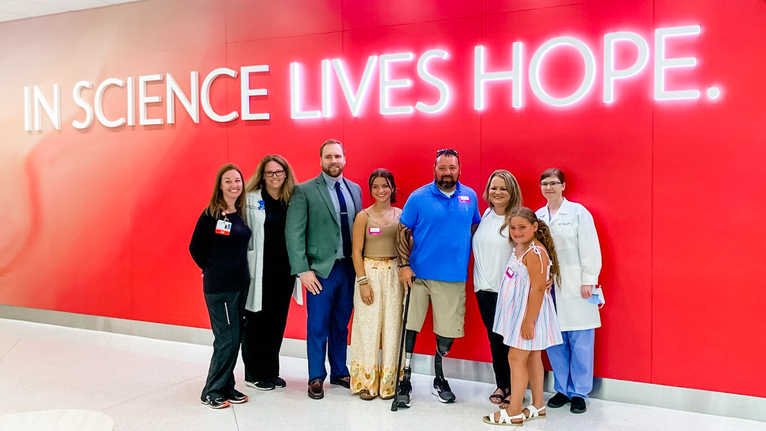Two Months in the ICU
Alissa remembers it all—all 30-some days Travis was in a coma, on a ventilator, with a tracheostomy, barely able to communicate by weakly and shakily writing on a whiteboard. She spent long days and even longer nights by Travis’ side, her faith never wavering.
Vanessa Nomellini, MD, UC Health trauma and surgical critical care physician, cared for Travis during the two months he stayed in the surgical intensive care unit, and continues to stay in touch with the family as a friend.
“It was very clear to us early on that the fight that he had was going to be a big part of his care and in his recovery,” she said of Travis’ spirit. “He remembers waking up, he remembers Alissa being at the bedside—it was a big shock to him, looking down. He asked Alissa, ‘will you still love me like this?’, and as soon as she said ‘yes,’ it was game on for him.”
Care team members—from nurses, surgeons and therapists to the support staff cleaning—all went above and beyond for Travis and Alissa, acting as bright moments in their darkest days.
“One of the doctors got me by myself once, and he asked me if I had eaten anything,” she remembered specifically. “He didn’t have to care about me or if I ate—I’m sure he’s a very busy man, but he was genuinely concerned about my wellbeing. He looked at me and told me Travis is going to be OK, and he gave me his personal phone number, telling me to call him if I had any trouble.”
Even though her time spent at UC Medical Center posed some of the toughest days, Alissa looks back on it fondly.
“They all went above and beyond,” Alissa said of the UC Medical Center teams. “It was like a big puzzle—every rescue person, every doctor, every nurse, every respiratory therapist, every person who came in as a student to train, everyone who came in to change the garbage who just smiled nicely—it makes a difference. They made sure I had what I needed, and they took care of Travis like he was one of their own. They gave me a great, thorough rundown every single day, and they were all so kind to me.”
Rehabilitation at Daniel Drake Center
On Feb. 4, 2021, Travis and Alissa moved to Encompass Health within UC Health’s Daniel Drake Center for Post-Acute Care, so Alissa could be at Travis’ side every step of the way. During rehabilitation, Travis had to relearn every aspect of his day-to-day life, including how to walk with two prosthetic legs.
“When I got to rehab, I was still bedfast for 30 days,” Travis remembered. “Once I was able to get up, Dr. [Holly] Pajor was able to rush a prosthetic for me. I was able to stand up for the first time on March 9, I believe, but I didn’t realize how weak I was. It was very, very hard to start taking those steps again.”
Holly Pajor, DO, physical medicine and rehabilitation physician at UC Health, started Travis’ rehabilitation care from the bedside in the ICU, just three weeks after he arrived, and after both limbs had been amputated.
“When he arrived at rehab, we weren’t able to do much with him out of his bed because he still had restrictions,” Dr. Pajor recalled, “but this man is motivated.”
After Dr. Pajor and Travis worked to build back his strength, Travis was discharged and sent home to continue outpatient rehab. All the while, Travis was in his wheelchair doing yardwork, cleaning up around the house and taking care of his kids.
Ninety-five days after being trapped under a 14-story building, Travis returned home to his family in Grayson, Kentucky with Alissa.
“We had Christmas when I got home,” Travis said proudly. “It was a lot of falls; a lot of pain and anguish, but here I am. I have a great life—the only thing different is my legs, but as far as life, it goes on. I go to the gym three days a week on my own, I swim, hunt, we’ve been fishing once this year. I did a race—I didn’t come in first, but I finished it. I’m very active—as long as I’m doing something or trying to do something. I at least try.”
In his continuum of care, he traveled to Chicago to see a specialist for the prosthetic on the right side—one that included two joints—his hip and his knee.
“This was with the help of David Rotter and his amazing team in Joliet, Illinois,” Alissa said. “Without him, we wouldn’t be where we are. His talent plus Travis’ drive and determination to live is the reason he walks.”
Travis walked on two prosthetic legs—a right hip disarticulation and left leg below the knee—exactly four months after leaving rehab.
“It takes people 6 months to a year to be able to master walking with a double-joint prosthetic like that, and not to mention on two prosthetics,” Dr. Pajor explained. “But I got a text from his prosthetist within five minutes of Travis having this prosthetic, and he was walking between the parallel bars. It was just so inspiring to see.”
Alissa and Travis continually sing the praises of their UC Health care teams—from their meeting Dr. McMullan at the helicopter, to their texting with Dr. Nomellini to share milestones even today.
“’Thank you’ is not enough,” Travis and Alissa said. “We cry happy tears every day. Without these people, the gifts they’ve been given, their ongoing education—Travis wouldn’t be here if it wasn’t for them.”




